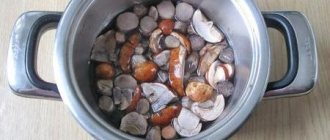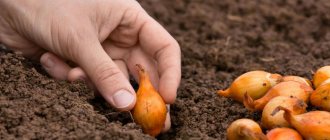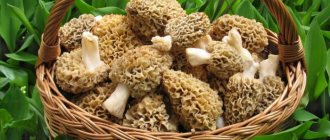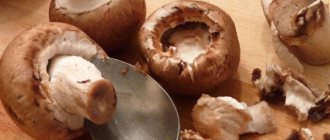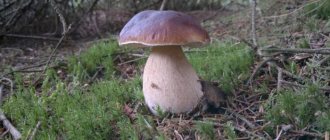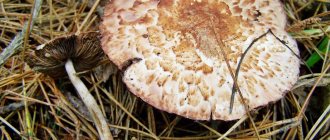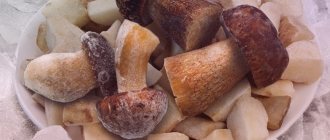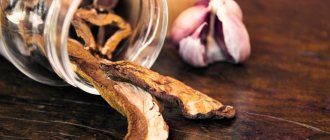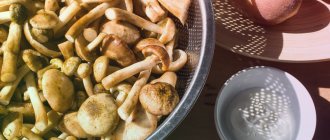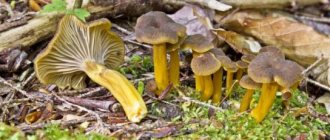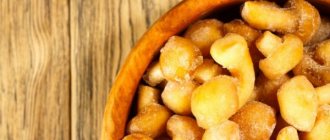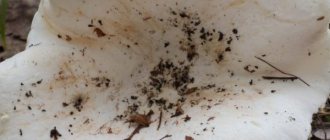When starting to prepare a dish based on this wonderful product, it is important to be sure that the collected or purchased gifts of nature must be edible and palatable.
After making sure that the product is suitable for food, you need to choose a heat treatment method. For example, I pickle honey mushrooms, dry them, and freeze forest gifts.
To get a truly tasty and delicious dish, you need to monitor the quality of the mushrooms, as well as choose the most gentle cooking method to preserve the nutrients.
To determine whether a mushroom is edible or not, it is recommended to boil it with an onion. If the onion turns blue, then you shouldn’t eat the mushrooms, this means that they are not edible, or you have gone too far, and among the edible ones, you came across an inedible one.
Preparing mushrooms
After collecting the mushrooms, it is advisable to clean them on the same day, remove dark places, and cut off parts affected by slugs and worms. For old mushrooms, trim off the bottom of the cap.
If cooking mushrooms is postponed, they must be placed in the refrigerator for safekeeping. This product is not washed, but only carefully cleaned off with a knife the adhering particles of sand, leaves, blades of grass and other small specks.
Just before cooking, the mushrooms are rinsed in cool water, but this should be done quickly so that they do not have time to absorb a lot of moisture.
Pros and cons of pre-cooking mushrooms
The need for cooking is due to the fact that during growth, mushrooms absorb toxins from the soil. Large specimens in this regard are more dangerous than small ones.
The point of pre-heat treatment is to remove all harmful substances from the mushrooms
In addition, large mushrooms also accumulate their own waste products, which makes them hazardous to health.
An undeniable advantage of pre-heat treatment of mushrooms is the reduced risk of poisoning. The only downside is the deterioration in the taste of the product, but this is only possible if it is cooked for too long.
How to cook wild mushrooms correctly
For each type of mushroom, the entire cooking process will take a different amount of time. Some of them require more time, while others, on the contrary, are ready in 5 minutes.
There are also those that need to be pre-soaked. Be sure to wash it well, you can use a brush.
You need to boil them as follows:
- Thoroughly clean from dust and other dirt;
- Cut off the bottom;
- Thoroughly rinse the gifts of nature;
- Cut large mushrooms into pieces and place in a metal or enamel container. Small ones can be left in their original form.
- Fill the container so that the mushrooms float freely in it.
- Place the container to heat, wait for the liquid to boil and boil for 20 minutes, depending on the variety, if the mushrooms are bitter, then increase to 40 minutes;
- Stir occasionally, do not allow the contents to stick to the bottom;
- If desired, you can add salt before removing the dish. The same can be done during subsequent preparation of the dish;
- Transfer the boiled products to a sieve to drain excess liquid.
Dried
1. Rinse the mushrooms with running water, place in a container and add 1.5 cups of water.
2. Soaking depends on the degree of dryness - from 1 to 5 hours.
3. Transfer the product into a container and add the water in which they were soaked.
4. Let the liquid boil and cook for another 25 minutes.
Fresh
This method will help determine the presence of poisonous mushrooms among edible ones in a pan. During cooking, you need to lower the peeled onion; if it turns blue, it means there are poisonous mushrooms in the pan.
Any variety of mushrooms is boiled for 20 minutes after the liquid boils. Boiled mushrooms must be rinsed with cold boiled water. Larger ones cook much faster than smaller ones. Therefore, if desired, they can be cut.
Readiness is determined quite simply: cooked mushrooms float to the surface, while raw mushrooms remain at the bottom.
Frozen
1. Before boiling, shake the frozen product a little in the bag, then defrost using any of the following methods. This can be done on a shelf in the refrigerator, or you can leave the mushrooms to defrost at room temperature or put them in warm water. A microwave oven is suitable for quick defrosting.
2. Boil the liquid at the rate of one glass of water per glass of frozen mushrooms, add salt with a pinch of salt.
3. If necessary, cut the mushrooms into smaller pieces if they are large in the pack. Place them in water.
4. Boil honey mushrooms, chanterelles and champignons for a quarter of an hour.
5. For frozen store-bought products, increase the time to 25 minutes.
6. Mushrooms that are frozen independently without pre-cooking should be boiled for about half an hour.
Instructions for cooking mushrooms
- Dried mushrooms are pre-soaked for three and a half to four hours. The water should be cool. Frozen mushrooms are first defrosted naturally or using a microwave.
- The prepared mushrooms are washed. Large ones are cut into pieces. Then they are placed in an enamel container and filled with water.
- The mushrooms need to be boiled. The boiled water is immediately drained.
- Clean water is poured into the container again and the mushrooms are sent to cook. After boiling, they must be covered and continued cooking over low heat, stirring regularly and removing the foam.
- Add salt.
- Cooking times vary for different types of mushrooms. When the mushrooms are cooked, they are thrown into a colander and the liquid is poured out. The mushrooms need to sit for about an hour.
How long does it take to cook mushrooms?
The milk mushrooms are boiled for 15-20 minutes.
Honey mushrooms will take 40-60 minutes.
Porcini mushrooms are processed for 30-50 minutes.
Chanterelles and boletuses will be cooked in 20 minutes.
Boletus and russula are boiled for about 30-40 minutes.
For boletus and moss mushrooms it will take 25-35 minutes.
Boiling morels takes about half an hour.
Fkusnofacts
— are collected
from early June until late autumn in coniferous, mixed or deciduous forests. They appear in warm and humid weather. These mushrooms love to grow near pine, spruce, birch, beech, oak, or even in juniper. Most often it hides in the grass and under fallen leaves. It prefers to grow in families, although you can also find a solitary mushroom. The neighbors are often a red fly agaric or an anthill. They can also grow on the edge of the forest in sparse forest.
— Porcini mushrooms are slightly different in appearance
, depending on where they grow. The cap of this mushroom has a pleasant smell, is velvety to the touch and can be from brown-white to dark brown in color. Sometimes you can find a red-brown or almost yellow cap. The diameter of the cap can reach 40 centimeters in diameter. The leg has a barely noticeable brown tint with white mesh. It can be either flat or widening towards the bottom with a diameter of up to 25 centimeters.
— A mature mushroom has yellow or slightly greenish pores
. In a young mushroom they are white. In rainy weather the hat becomes slippery.
— Price
dried porcini mushrooms - from 250 rubles/50 grams (data for Moscow as of June 2021) From 50 grams of dried porcini mushrooms, you get about 300 grams of soaked ones.
— The porcini mushroom does not darken
when cut and retains color during any processing. The white flesh of this mushroom remains white even after drying. That's why it's called that.
How long to cook dried porcini mushrooms?
Soak dried mushrooms in cold salted water (in this ratio - 1 glass of water per handful of mushrooms) for 2-3 hours. Then, without changing the water, put on the fire and cook the chopped mushrooms for 30 minutes, whole mushrooms for 40 minutes.
How long should you cook porcini mushrooms before frying?
Porcini mushrooms, due to frequent cases of poisoning, should be boiled in salted water for 20 minutes after boiling. Then you can fry the porcini mushrooms.
How long to fry porcini mushrooms after cooking?
After cooking, place the porcini mushrooms in a colander, heat the frying pan, add the porcini mushrooms and fry for 15 minutes
How to dry porcini mushrooms In the microwave
: place the porcini mushrooms on a dish, set the power to 100-180 W and leave for 20 minutes.
Then ventilate the microwave for 5 minutes and repeat the same 2-3 times. In the oven
(including an electric oven): place the porcini mushrooms on baking paper, dry at a temperature of 50 degrees, the oven door should be slightly open. Drying time for porcini mushrooms in the oven is about 6-7 hours.
Benefits of porcini mushrooms
The benefits of porcini mushrooms are due to the content of vitamins E (healthy cells), ascorbic acid (immunity), nicotinic acid (redox processes), folic acid (health of the circulatory system), thiamine (health of nerve cells) and riboflavin (vision, energy).
Calorie content of porcini mushrooms
30 kcal/100 grams.
How to properly boil mushrooms for freezing
Before freezing mushrooms, they must be boiled for 5-10 minutes.
It is recommended to slightly dry the prepared product, package it in plastic bags or place it in containers, and then put it in the freezer. Plastic containers are also useful for these purposes.
When can you fry mushrooms raw?
Not all mushrooms, even the freshest ones, are suitable for frying without prior heat treatment. For example, milk mushrooms, morels, stitches, svinushki, oak mushrooms are not suitable for this purpose.
Suitable for frying raw (uncooked):
- boletus mushrooms (ceps), especially from under the spruce forest
- saffron milk caps
- boletus
- boletus
- boletus
- honey mushrooms
- chanterelles
- umbrella mushrooms
- Russula.
Here you also need to take into account the fact that these mushrooms should be collected away from industrial zones, highways, railways, in other words, in environmentally friendly places.
If you picked the mushrooms yourself and are confident that they are environmentally friendly, then feel free to fry them without first boiling them. But if you bought mushrooms that were not known where they were collected, then it is better to boil them before frying.
How to boil mushrooms before frying
Before frying, the gifts of nature must be boiled for 20 minutes. Cooking boletus mushrooms will take a little longer, 40-60 minutes.
The same amount of time will be required to cook boletus mushrooms.
Cooking steps:
1. Mushrooms are cleaned from the bottom of the cap.
2. Wash under running water to remove dust and dirt.
3. Place in an enamel bowl, which is filled with water so that the mushrooms move freely in it.
4. After waiting for it to boil, boil the product for 20-60 minutes, depending on the type of mushroom. Make sure that the contents do not stick to the walls or bottom of the pan.
5. At the end of cooking, you can add salt and spices, or do this during the subsequent cooking stage.
Cream of porcini mushroom soup
Products
Porcini mushrooms - half a kilo Onions - 2 heads Potatoes - 2 large potatoes Cream 20% - 1 glass Dill - a small bunch Vegetable oil - 2 tablespoons Italian seasonings, salt and pepper - to taste.
Recipe for creamy porcini mushroom soup in a saucepan
Fry finely chopped onions in vegetable oil, add mushrooms to the onions in a frying pan, fry over low heat for 5-7 minutes, then pour in the cream (carefully, in a thin stream), add peeled and diced potatoes, and cook for 20 minutes over low heat. . Pour the resulting mixture into a saucepan, bring to a homogeneous mass in a blender or mixer, season with spices, and garnish with dill. Serve with pleasure!
Recipe for creamy porcini mushroom soup in a slow cooker
Set the multicooker to the “Baking” mode. Place chopped onion in the multicooker container, fry it in the multicooker for 10 minutes, add chopped potatoes, mushrooms, close the multicooker lid and cook for 40 minutes. Then add cream, salt and spices, and continue cooking for 10 minutes on the same mode. Then grind the soup into puree and cook for 5 minutes on the “Steam” mode. Serve creamed porcini mushroom soup, garnished with herbs.
How long does it take to cook champignons?
To determine the cooking time, you need to focus on the following numbers:
- Fresh mushrooms are cooked in a saucepan for 5 minutes;
- In a double boiler, the cooking time will take 10 minutes;
- In a multicooker, you should select the stewing mode - 20 minutes, without adding water;
- In a pressure cooker, cook the product for 5 minutes;
- After defrosting, frozen champignons should be boiled for 10 minutes.
Cooking champignons
1. First, the mushrooms are washed and cleared of debris.
2. Pour liquid into the container so that it lightly covers the mushrooms.
3. Boil water and add champignons, boil for about 5 minutes.
4. Drain the liquid, placing the cooked mushrooms in a colander.
Why cook mushrooms
There are several types of heat treatment of harvested forest crops. Cooking is one of the simplest and most common methods. Why is it needed?
- Firstly, mushrooms contain alkaloids that are hazardous to health. These are toxic compounds that should definitely be disposed of. Some types of mushrooms, for example, contain gilvelic acid. This is a powerful poison that has a destructive effect on the liver and kidneys and leads to death in 30% of cases. The poison is contained by strings - mushrooms very similar to morels. When cooked, it turns into liquid, so suspicious mushrooms are boiled in two waters, the first one must be drained, and the mushrooms are washed after it.
- It is no coincidence that mushrooms are compared to a sponge. They instantly absorb all dirty and harmful substances from the environment, including radiation. Boiling helps reduce its level; with a single boil for ten minutes, the radiation level is reduced by 80 percent, and with a double boil, by 97 percent.
- Cooking allows you to get rid of microscopic parasites, larvae, microorganisms, in general, to protect the human gastrointestinal tract as much as possible.
- In addition, some types of mushrooms that do not pass the boiling water test may taste bitter. Therefore, you need to cook not only dangerous strings (which, in fairness, rarely end up in a mushroom picker’s basket), but also everyone’s favorite chanterelles, russula, milk mushrooms and even store-bought champignons.
- How to cook mushrooms depends on their type. However, it is important to understand that when boiling, some of the nutrients and vitamins will go into the broth. Therefore, you need to pour a little water into the pan so that it only slightly covers the mushrooms.
Fresh white mushrooms - proper cooking
1. Prepare the mushrooms, thoroughly clean them of dirt, cut off the wormy parts and very little of the end of the stem.
2. Rinse under water.
3. Place the mushrooms in a container filled with water and leave them in this form for an hour to allow particles of dirt, small and large debris to completely settle.
4. Remove the skin from each mushroom and chop.
5. Place the pre-prepared porcini mushrooms in a pan filled with water, so that the liquid covers the tops of the mushrooms by 2 cm.
Add salt in the amount of 1 teaspoon per 1 liter of water. Place the container on the fire.
6. After boiling, constantly remove the resulting foam.
7. After 40 minutes, the dish is ready. To add additional aroma and taste to the broth, you can add various spices to it and continue cooking for another 15-20 minutes.
Useful tips
To make dishes made from dried mushrooms have a milder taste, they are soaked in cold water for two to three hours. Since dried mushrooms are usually not washed, they need to be washed thoroughly after soaking. Also, when soaking, dried specks are washed off well.
Sometimes the liquid in which they were soaked is used for cooking. It is believed that this will make them tastier and more aromatic. But there may be debris left there, and the water may have a bitter taste and the taste of the finished product will be unpleasant.
After cleaning, cut the mushrooms, place them in a suitable container and pour cold water. Boil the mushrooms, remove the resulting foam and cook over medium heat. Cooking time depends on what type of mushroom is used and ranges from thirty minutes to one and a half hours.
The dried product has a rich taste. For this reason, mushrooms are taken in small quantities for cooking. For a liter of sauce there is a handful of dried product, and for soup - one large handful for three to four liters.
Do I need to boil chanterelles before frying?
Before frying, it is better to boil the forest products.
1. Before proceeding to cooking, the product is thoroughly cleaned, rinsed and prepared for further processing.
2. It is recommended to fill them with milk or cool water for an hour and a half. This will make the chanterelles more tender.
3. Pour the product into a suitable container.
4. You will need twice as much liquid as the chanterelles themselves. For 1 glass of product you will need 2 glasses of water.
5. Season with salt or do not do this at all if you plan to prepare dishes based on them in the future.
6. Cooking duration: 20 minutes.
7. Periodically it is necessary to remove the foam.
8. Place the finished chanterelles in a colander and let the liquid drain.
9. If the chanterelles are dry, pre-soak them for an hour, and then cook in the usual way for about 20 minutes.
Chanterelles
Chanterelles are funnel-shaped mushrooms with a dense, fleshy cap. In young specimens it is almost flat, with a rolled edge. The plates are sparse, branched, thick, descending along the stalk. In the old days, mushrooms were called fox mushrooms, that is, yellow ones. In nature, they can be confused with false chanterelles.
Real chanterelles are never wormy and do not break. But they are bitter, so they are soaked in milk before cooking. Cooking time is only 20 minutes.
Cooking technique:
- Thoroughly clean the chanterelles of debris and rinse in a colander.
- Soak in cold water or milk for 1–1.5 hours.
- Place the chanterelles in a saucepan and cover with cold water (1 cup per 2 cups of liquid).
- Bring to a boil, cook over medium heat until tender (20 minutes).
- Skim off foam during cooking.
- Place the finished chanterelles in a colander.
When preparing as a separate dish, salt them during cooking. Accordingly, you don’t need to do this if you plan to put chanterelles on a salad or roast, which is supposed to be salted during the cooking process.
How long to cook the butter before it's ready?
1. After cleaning the butter, cut into slices or cubes.
2. Pour water over the mushrooms so that it completely covers them.
3. Place the container on the fire, lightly add 1 teaspoon of salt per 1 liter of water.
4. Boil for about 30 minutes after boiling.
5. Drain off any excess liquid by placing the mushrooms in a colander.
How long to cook frozen mushrooms
You can cook the same wonderful dishes from frozen mushrooms as from fresh ones. They freeze champignons, boletus, white mushrooms, honey mushrooms, chanterelles - almost everything that can be brought from a successful mushroom hunt.
How long to cook frozen mushrooms? Before answering this question, you need to know how to prepare mushrooms for cooking.
The fact is that it is not possible to remove all the moisture from mushrooms before freezing: a small amount of ice will certainly form on them. You can’t throw mushrooms in this state into the pan, they will ruin the whole thing. Therefore, the mushrooms need to be defrosted first. You can do this in several ways:
- microwave for a couple of minutes;
- leave in a colander at room temperature and wait for natural thawing.
After the mushrooms have thawed, they must be washed in running water. Then everything is simple: add water to the mushrooms and put them on the fire. After boiling, reduce the heat to low and simmer, covering with a lid. Be sure to stir from time to time and remove the foam with a slotted spoon.
How long to cook frozen mushrooms? For complete readiness, 20-30 minutes will be enough. The champignons will be ready in 15 minutes.
How much and how to cook boletus and boletus
1. After preliminary preparation, including cleaning and removing the film on the surface of the cap, begin cutting up wild mushrooms.
2. Cut mushrooms can be kept in cool water for an hour. This process is more additional than basic. It can be lowered.
3. Pour the product into the container, pour cold water and turn on the heat. Add a little salt and get rid of any foam that appears.
4. After boiling, boil for a quarter of an hour, reducing the heat to minimum. At the end of cooking, change the water to a new one, let it boil and cook for another 5 minutes.
5. Vinegar added to water will protect the mushrooms from blackening.
1. Boletus mushrooms should be cooked longer, but you should start with cleaning.
2. Pour the prepared product into a saucepan, let it boil and cook for about 40 minutes. The water needs to be salted.
3. Then replace the liquid and boil for some more time. If the mushrooms sink to the bottom, then they are ready.
Boletus
Boletus is a mushroom with a characteristic hemispherical cap, colored in the colors of fallen aspen leaves. Its leg is dense and stocky. In nature, boletuses can be confused with gall mushroom.
Boletus mushrooms need to be cooked for 20 minutes from the moment they boil in the pan. In a slow cooker they are cooked for 30 minutes in the “stew” mode. Try to cook mushrooms within 2 days after picking.
- Clean the boletus from grass, pine needles, and dirt. Rinse in cold water. If you soak them in cold water for an hour before doing this, the dirt will come off easier.
- Pour water into the pan, add mushrooms. Boletus broth is used for soups and sauces. In this case, you need to measure the amount of mushrooms based on the recipe. So, for an ordinary soup, 300 g of boletus per 2 liters of water is enough.
- Place the pan over medium heat, add salt, add mushrooms, and bring to a boil. Next, cook for 20 minutes.
- Skim off foam during cooking.
- Remove the finished boletuses with a slotted spoon and place in a colander to drain.
- Strain the broth through a sieve or cheesecloth, then use for soups and marinades.
How to cook dried mushrooms for soup
1. Pre-soaking should be carried out for 2-3 hours or left overnight. Pour the product into the container and cover it with water 2-3 cm above the level of the mushrooms themselves.
2. Place the soaked dry mushrooms in a container and fill them with water; you can use the one you took for soaking if there is no dirt or other foreign matter in it. This will make the broth more tasty and rich.
3. Bring to a boil over high heat, then reduce, get rid of the foam and cook for half an hour.
4. Dishes using this product are aromatic and rich.
Dozens of types of dishes for every taste are created based on mushrooms. For soups, sauces, and pies, it is important to select only the best mushrooms that provide health benefits and delight the taste buds.
General recommendations
Wild mushrooms are a delicate and perishable product, so they are processed and prepared on the day of collection. Clean them of adhering leaves and soil, cut off the mycelium. Soaking in salt water for 2-3 hours or longer depending on the type will help get rid of worms and debris. Cultivated mushrooms (champignons, oyster mushrooms) do not require thorough cleaning and soaking.
It is safest to cook mushrooms in an enamel pan. To preserve flavor and aroma, keep heat to medium. At the same time, put a peeled onion in the water: if it turns blue, it means that there is a poisonous one among the noble specimens.
It is not difficult to determine that the mushrooms are cooked. Raw ones will float on the surface, ready ones will settle to the bottom.
How to use boiled mushrooms and mushroom broth
Fresh, dried and frozen boiled mushrooms rarely become a separate dish. Usually they are boiled for pickling, pickling, freezing (if the mushrooms are fresh). In addition, dried and frozen mushrooms are boiled to make soup, mushroom salad, filling in pies or pancakes, julienne, fried potatoes.
After cooking the mushrooms, the broth should not be poured out. This is a valuable food product, on the basis of which you can cook a light, aromatic soup or prepare a wonderful sauce for a meat or poultry dish.
The broth can be frozen in a plastic container or bottle. This is very convenient, because you can prepare soup or sauce with fresh mushroom broth at any time.
NEXT IS MORE INTERESTING...
Homemade no-bake jelly cheesecake is the perfect weekend dessert. Write down the recipe!
Delicious apple donuts in 20 minutes. An original treat for children and adults
Quick snack rolls made from bread with sausage and cheese. You haven't tried anything like this before!
A unique recipe for natural homemade ketchup - write it down so you don’t forget
Omelette with sausages and tomatoes in pita bread - tastier than shawarma
How to properly freeze green beans for the winter
Roasted potatoes in the village style with spicy spices
Eggplants for the winter are like mushrooms - an original snack
How to freeze corn kernels
The simplest khachapuri on kefir with cottage cheese in a frying pan. Author's photo recipe for cooking khachapuri in a frying pan with curd filling
Grated pie with jam - a quick morning surprise. Step-by-step photo recipe for crumbly shortbread pie with margarine jam
Delicious Potato Meatball Soup
How long to fry dried mushrooms after soaking
Drying is no less popular than freezing. The taste of mushrooms becomes concentrated, and dishes with them acquire a simply magical aroma.
Attention!
Two useful articles: What mushrooms are dried and how to store them correctly.
Before frying, the dried product should be kept in cold salted water or slightly warm milk. The duration of soaking ranges from 3 to 8 hours and depends on the method of dehydration of the mushrooms, as well as their size.
“Little ones” gain moisture faster, large specimens – slower. Mushrooms that were dried in the oven rather than in the open air also require a longer period. Their flesh is hard and dense, and therefore does not absorb liquid well.
After the drying has been completely restored, increased in size and saturated with moisture, you can start frying it.
Important!
First, the mushrooms are washed well, removing sand and dust.
Further actions:
- Heat a frying pan with a mixture of vegetable and butter - it will successfully highlight the aroma of our product.
- Add the mushrooms cut into strips, cover with a lid and simmer for 30 minutes, reducing the heat to low. Stir occasionally. At the end, remove the lid and brown the delicacy over higher heat for 5 minutes.
- We recommend trying dried mushrooms fried in batter - they turn out more juicy. The dish is also prepared within half an hour, but there is no need to cover it with a lid.
Names, photos and descriptions of popular edible forest mushrooms
Forest mushrooms are strikingly different from their greenhouse brothers. Firstly, the taste qualities are an order of magnitude higher, and secondly, the species diversity of forest fruits is much wider. In addition, mushrooms collected in the forest are obtained absolutely free, while for greenhouse mushrooms they ask for a lot of money. And the collection process itself is a very exciting event, not to mention the benefits of a long walk in the fresh forest air.
Mushroom picking
On the other hand, forest harvests can pose a threat to human health and life. The presence of dangerous poisonous counterparts and the wrong collection site can increase the risk of poisoning. Before going on a quiet hunt, a mushroom picker needs to familiarize himself with the list of names and descriptions of edible mushrooms, as well as their photos. You also need to determine a suitable collection location. And when you bring home a mushroom harvest, you should properly prepare it or store it.
You may be interested in:
How to distinguish real saffron milk caps from false mushrooms (28 photos)? Saffron milk caps are a popular forest delicacy in our country with an exquisite taste. Their taste qualities are not inferior to...Read more...
Porcini
Porcini mushrooms are often found under spruce and pine trees, as well as under oaks and birches. This species prefers old forests. The harvest peaks in August, but the harvest begins in early June, arriving in October.
The hat, in the form of a shallow dome, flattens a little over time. The surface of the cap may be smooth or slightly wrinkled. Its edges often crack. During periods of high humidity it is a little slimy, and in dry weather it is dry and matte. The surface color varies from red-brownish to white, depending on the variety and area. Most often, the shade of the edge of the cap is a little lighter.
The leg is thick, barrel-shaped. As it grows, it becomes cylindrical, with thickenings at the base. The color of the stem may match the color of the cap, but most often the first one is a tone or two lighter. Almost all varieties have a veined mesh of white or close to white shades on the stem. Basically, the mesh is clearly visible on the upper part of the leg.
You may be interested in:
How to recognize a mushroom with a cap and a white stalk: names and types (32 photos) Mushrooms are a wonderful culinary product, successfully used for preparing various dishes. The most…Read more…
The pulp is juicy, fleshy, and somewhat fibrous in older fruits. It often has a white or slightly yellowish tint and does not change color. The taste and aroma of the raw pulp is unexpressed. But during cooking, the pleasant mushroom aroma intensifies and acquires a sweetish note.
Porcini
The tubular layer is easy to separate from the cap. It is initially white in color, but turns yellow as it ages, eventually becoming olive in color. The spore powder is also olive green in color.
Chanterelles
Chanterelles can be found in various types of woodlands in early June and again between August and October. Their fruiting body is similar to the cap-shaped structure of mushrooms, but in chanterelles it does not have clearly defined boundaries. The color of the fruiting body varies from light yellow to orange.
The cap is concave and outstretched; over time, it flattens and takes on a funnel-shaped shape. The initially wavy edge turns up as the fox grows. The surface is smooth and matte.
The leg is smooth. It tapers a little towards the base. The pulp is dense, fleshy, slightly fibrous in the stem part. It is white, slightly yellowish along the edges. When pressed, it acquires a reddish tint. Chanterelle pulp exudes the aroma of dried fruit and has a sour taste. Chanterelles have a folded hymenophore, represented by wavy folds. The spores are light yellow in color.
You may be interested in:
Description of black chanterelles and where do these mushrooms grow (21 photos)? Chanterelles are one of the most famous and useful mushrooms, which have a rather unusual appearance.... Read more...
Talkers
Talkers grow in groups, often forming the so-called. witch circles (regularly shaped ring). You can meet them in forests of any type, as well as in some parks and squares.
The hat looks like a bell - its edges are folded, and there is a pronounced tubercle in the center. The surface is smooth, matte. The hat has a gray-brown or reddish color.
The leg is expressed in the shape of a cylinder. Structurally it is dense. The color of its surface matches the color of the surface of the cap. The pulp is dry, but fleshy, has a whitish color that does not change when broken or pressed. The pulp has an almond aroma. The spores are presented in the form of a light cream powder.
Saffron milk caps
Saffron milk caps grow in large groups mainly in coniferous forests. They bear fruit in waves. Peak activity occurs at the end of July and from August to September. The saffron milk caps are found from July to October.
The cap of young saffron milk caps has a convex shape with a curled edge. Over time, it straightens, taking a funnel-shaped shape, and the edges straighten out. Some saffron milk caps have a bump in the center. The surface is glossy and becomes sticky at high atmospheric humidity. The surface of the cap is orange in color with dark rings and spots.
The leg is smooth, cylindrical, structurally hollow. It is slightly narrowed at the base. The surface of the leg is completely covered with dimples. The color matches the color of the cap or may be a shade lighter.
The pulp is dense. It has a yellow-orange tint, which changes to green at the break. The flesh of saffron milk caps abundantly releases thick milky juice, which also turns green when exposed to air. The juice has a pleasant fruity aroma. The plates are thin, but frequent, colored orange-red. They turn green at the break. Spore powder is yellow in color.
Honey mushrooms
Honey mushrooms grow on rotten wood and old stumps. They are quite common in deciduous forests, and Meadow mushrooms prefer to grow in open grassy areas. Honey mushrooms can be collected all year round.
The cap is hemispherical, convex. Over time, it changes, becoming umbrella-shaped with a pronounced tubercle in the center. Very old honey mushrooms have outstretched caps. The color is represented by shades of brown. In conditions of high humidity, the caps darken, and after drying they again acquire their usual color. Some species have numerical scales on the surface. However, for many of them they disappear with age.
The leg of honey mushrooms is cylindrical. It's hollow inside. In some species the leg is thickened towards the base. Certain species have a skirt or mushroom ring. The surface of the leg is painted with shades of brown. In old mushrooms, the stem is always darker than in young mushrooms.
The pulp is thin, often watery. In many species it is white, but there are also species with yellowish flesh. The pulp of honey mushrooms has a pleasant mushroom smell and a sweetish taste. The plates are loose, white or cream in color. In certain honey mushrooms, they change color upon contact with air or water.
boletus
Boletus mushrooms can be found in any forests where birch trees grow. With these trees, this type of fungus forms mycorrhiza. Boletus mushrooms begin to actively bear fruit in the first half of summer. You can collect them until October inclusive.
The boletus has quite a large number of varieties, so the color and shape of the cap vary. Mushrooms are recognized by their white stalk, completely covered with black and white scales. The leg has a slight thickening at the bottom. The flesh of boletus is white and does not change color. The only exception is the Reddening species, whose representatives have a reddish tint to the flesh when cut.
Butter
Butterflies are very common and have a wide variety of species. They are found in forests of various types, mainly in coniferous plantations. Boletus can be collected from July to September.
The cap is convex and becomes flatter as it ages. The surface of the cap is smooth. Sometimes there are remnants of a black blanket on it. The surface is always sticky or slimy. The color of the cap depends on the species (yellow, orange, brown).
The leg has a club-shaped shape, a smooth or granular surface. It's solid inside. The color of the leg completely matches the color of the cap. Remnants of a black blanket or a mushroom ring may be located on the surface.
The pulp is soft and juicy. It may be whitish or yellowish in color. In some species, the flesh takes on a bluish or reddish tint when cut. The hymenophore is easily separated from the cap and has a yellow or white color. The spores are yellow.
Russula
Russulas have a huge number of species, most of which are classified as edible. In Russia alone there are 60 species of these mushrooms.
Initially, the cap may have a spherical, bell-shaped or hemispherical shape. As it matures, it becomes prostrate, flat, funnel-shaped and very rarely convex. The edges can be either rolled or straight. Often they have stripes or scars, sometimes the edges are covered with cracks. Depending on the type, the surface can be dry or wet, shiny or matte. The color can be varied.
The leg is thickened, smooth, sometimes widened or narrowed at the base. It can be hollow or dense inside. The color of the stem depends on the species of russula. The pulp is fragile, dense or spongy. In young individuals it is presented in white color, in aging individuals it has a brownish or other dark shade.
Milk mushrooms
Milk mushrooms are common in deciduous and mixed forest plantations. They are collected from July to September inclusive.
The cap of young milk mushrooms is adjacent to the stem with its edges. Over time, it straightens out, acquiring a flat, plano-concave, or less often funnel-shaped shape. There is often a depression or bump in the center of the cap. The edges are smooth, but some milk mushrooms have caps with a wavy edge. The color can be varied.
The leg has a cylindrical shape with a narrowing or widening at the base. The color of its surface repeats the color of the cap or has a lighter shade. The pulp is firm with a specific fruity smell. As a rule, the flesh of milk mushrooms is white with a fawn, cream, or grayish tint. The plates are frequent, wide, white-yellow in color. Spore powder comes in shades of yellow.
Oyster mushrooms
Oyster mushroom grows on the trunks of weakened and dry deciduous trees. Mushrooms grow in bunches of about 30 fruits each. The mushroom season begins in September and lasts almost until the New Year. A pleasant feature of these mushrooms is the complete absence of inedible counterparts, at least in our latitudes.
The cap is shell-shaped with a wavy edge. The surface is smooth, glossy. The color of the cap can vary from ash-gray, gray with a purple tint to dirty yellow. The leg is very dense. Its surface is often white, sometimes acquiring a grayish tint.
The pulp has the taste of anise, there is no pronounced odor. Its structure is fibrous, especially in the pedicle area. With age, the pulp loses its juiciness, becoming very elastic. Therefore, only young mushrooms have culinary value. The plates are wide, but infrequent. They are painted white with a yellowish or grayish tint. Spore powder is colorless.
Truffle
The black diamonds of cooking—truffles—grow underground. Sometimes they are found at a depth of about half a meter. The habitats are oak and beech forests. These mushrooms have a very high culinary value and are considered a delicacy.
Truffle
The fruiting body has a tuberous shape. The outside of the truffle is covered with a leathery layer. The surface can be smooth or warty, often covered with cracks. The cut truffle has a marble pattern due to numerous dark and light veins. The pulp has a whitish or yellowish-brown tint. It tastes like roasted sunflower seeds and nuts.
